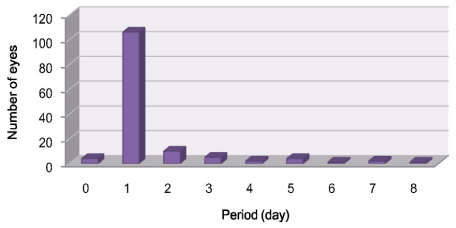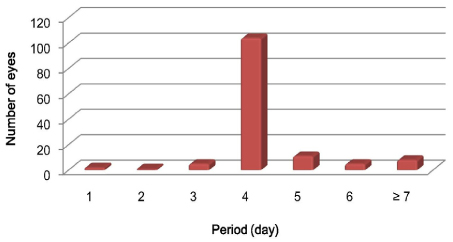J Korean Ophthalmol Soc.
2012 May;53(5):647-651.
Use of Prophylactic Antibiotics in Glaucoma Surgery: A Single Center's Experience
- Affiliations
-
- 1Department of Ophthalmology, Asan Medical Center, University of Ulsan College of Medicine, Seoul, Korea. sungeye@gmail.com
Abstract
- PURPOSE
To evaluate the use of prophylactic antibiotics in glaucoma surgery and the prevalence of postoperative endophthalmitis.
METHODS
Retrospective medical record review was performed on 136 eyes which underwent glaucoma operation by one surgeon from March 2008 to February 2010 and were followed at least till 6 months postoperatively (glaucoma drainage device implantation; 95 eyes, trabeculectomy; 41 eyes).
RESULTS
For intravenous antibiotics injection, 10 eyes used 3rd generation cephalosporin, 54 eyes used 4-fluoroquinolone, 72 eyes used 2nd generation cephalosporin. For oral antibiotics, 125 eyes used 3rd generation cephalosporin, 1 case used 4-fluoroquinolone, and other 10 cases did not use oral antibiotics after the surgery. Total period of systemic antibiotics use showed various distributions with 14 eyes more than 5 days, 115 eyes 4-5 days, and 8 cases less than 4 days. Six eye which used 4-fluoroquinolone and 3 eyes which used cephalosporin showed side effect such as skin lesion and nausea. There has been no single occurrence of endophthalmitis.
CONCLUSIONS
Various kinds of prophylactic antibiotics were used for glaucoma surgery and the period of antibiotics use was different among patients. However, there has been no single occurrence of endophthalmitis till 6 months postoperative follow up.
Keyword
MeSH Terms
Figure
Reference
-
1. Armaly MF. Lessons to be learned from the Collaborative Glaucoma Study. Surv Ophthalmol. 1980. 25:139–144.2. Lundberg L, Wettrell K, linner E. Ocular hypertension. A prospective twenty-year follow-up study. Acta Ophthalmol. 1987. 65:705–708.3. Grant WM, Burke JF Jr. Why do some people go blind from glaucoma? Ophthalmology. 1982. 89:991–998.4. Seo BR, Min WK, Ahn BH. Treatment of infectious endophthalmitis. J Korean Ophthalmol Soc. 1991. 32:561–568.5. Brod RD, Flynn HW. Advances in the diagnosis and treatment of infectious endotphthalmitis. Curr Opin Ophthalmol. 1991. 2:306–314.6. Kattan HM, Flynn HW Jr, Pflugfelder SC, et al. Nosocomial endophthalmitis survey. Current incidence of infection after intraocular surgery. Ophthalmology. 1991. 98:227–238.7. Goldstein MH, Kowalski RP, Gordon YJ. Emerging fluoroquinolone resistance in bacterial keratitis: a 5-year review. Ophthalmology. 1999. 106:1313–1318.8. Mather R, Karenchak LM, Romanowski EG, Kowalski RP. Fourth generation fluoroquinolones: new weapons in the arsenal of ophthalmic antibiotics. Am J Ophthalmol. 2002. 133:463–466.9. Bohigian GM, Olk RJ. Factors associated with a poor visual result in endophthalmitis. Am J Ophthalmol. 1986. 101:332–341.10. Ciulla TA, Starr MB, Masket S. Bacterial endophthalmitis prophylaxis for cataract surgery: an evidence-based update. Ophthalmology. 2002. 109:13–24.11. Ou JI, Ta CN. Endophthalmitis prophylaxis. Ophthalmol Clin North Am. 2006. 19:449–456.12. Mandelbaum S, Forster RK. Endophthalmitis associated with filtering blebs. Int Ophthalmol Clin. 1987. 27:107–111.13. Wolner B, Liebmann JM, Sassani JW, et al. Late bleb-related endophthalmitis after trabeculectomy with adjunctive 5-fluorouracil. Ophthalmology. 1991. 98:1053–1060.14. Gedde SJ, Scott IU, Tabandeh H, et al. Late endophthalmitis associated with glaucoma drainage implants. Ophthalmology. 2001. 108:1323–1327.15. AI-Torbak AA, AI-Shahwan S, AI-Jadaan I, et al. Endophthalmitis associated with the Ahmed glaucoma valve implant. Br J Ophthalmol. 2005. 89:454–458.16. DeBry PW, Perkins TW, Heatley G, et al. Incidence of late-onset bleb-related complications following trabeculectomy with mitomycin. Arch Ophthalmol. 2002. 120:297–300.17. Lehmann OJ, Bunce C, Matheson MM, et al. Risk factors for development of post-trabeculectomy endophthalmitis. Br J Ophthalmol. 2000. 84:1349–1353.18. Jampel HD, Quigley HA, Kerrigan-Baumrind LA, et al. Risk factors for late-onset infection following glaucoma filtration surgery. Arch Ophthalmol. 2001. 119:1001–1008.19. Wykoff CC, Parrott MB, Flynn HW Jr, et al. Nosocomial acute-onset postoperative endophthalmitis at a university teaching hospital(2002-2009). Am J Ophthalmol. 2010. 150:392–398.20. Lipsky BA, Baker CA. Fluoroquinolone toxicity profiles: a review focusing on newer agents. Clin Infect Dis. 1999. 28:352–364.21. Cunha BA. Antibiotic side effects. Med Clin North Am. 2001. 85:149–185.
- Full Text Links
- Actions
-
Cited
- CITED
-
- Close
- Share
- Similar articles
-
- Comparative Study of Single-dose Prophylactic Antibiotics after Cord Clamping Vs. Multi-dose Postoperative Antibiotics in Operative Complications after Elective Cesarean Section
- Comparing the Postoperative Complications, Hospitalization Days and Treatment Expenses Depending on the Administration of Postoperative Prophylactic Antibiotics to Hysterectomy
- Comparison of Infection Rates according to the Period of Prophylactic Antibiotic Use after Surgery in Patients with Distal Radius Fractures
- Are prophylactic antibiotics necessary in elective laparoscopic cholecystectomy, regardless of patient risk?
- Prophylactic effect of topical betaxolol and dorzolamide on the fellow eye in unilateral canine primary angle closure glaucoma: 60 cases (2016.1-2021.5)



